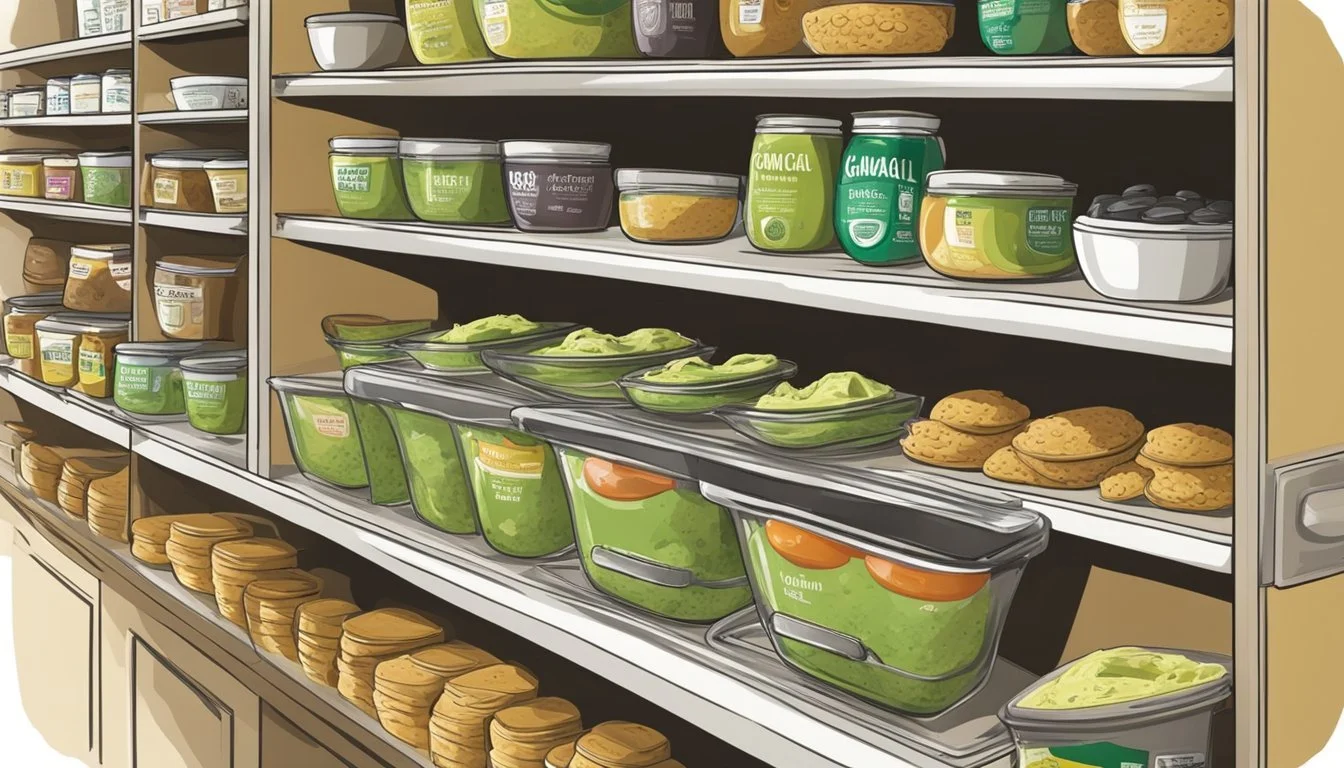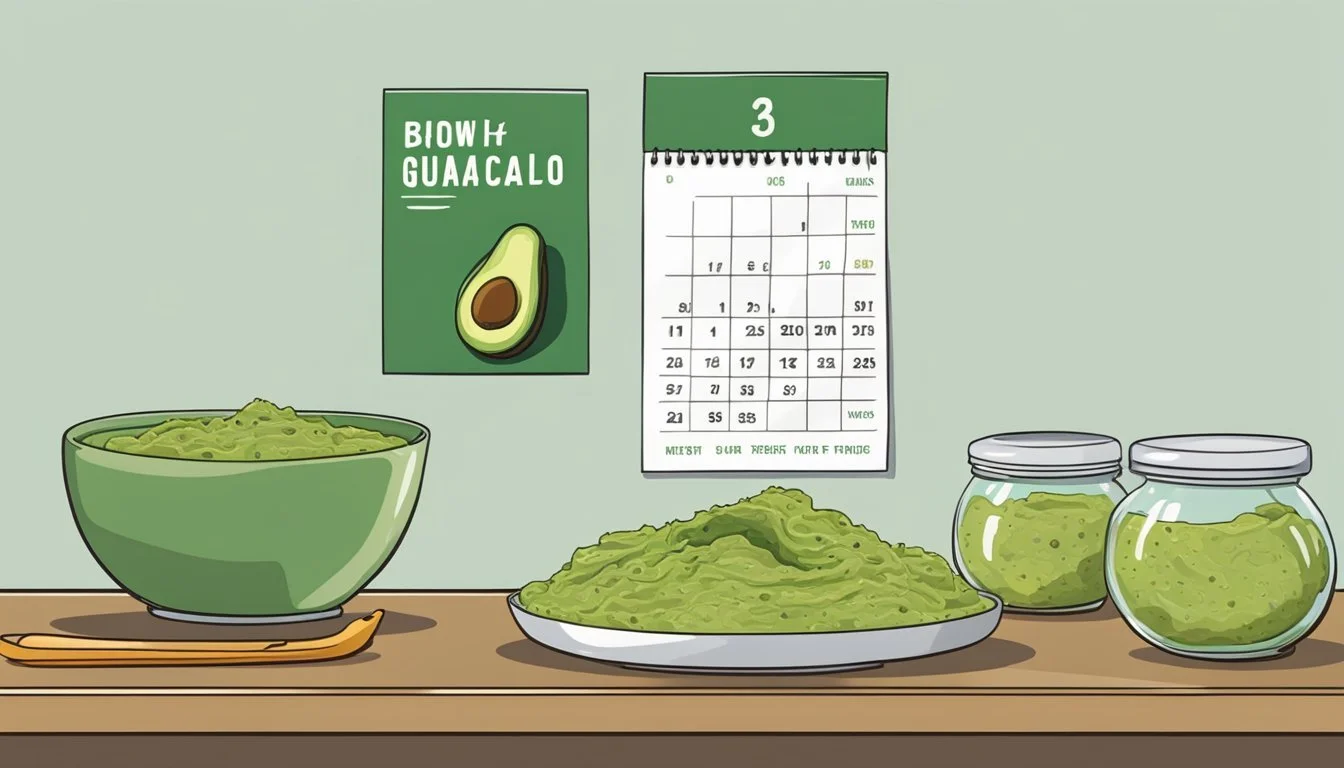How Long Does Guacamole Last?
Shelf Life and Storage Tips
Guacamole, a popular dip made from avocados, is not only a delicious accompaniment to many dishes but also a nutrient-rich addition to any meal. However, its shelf life is a common concern for both home cooks and guacamole aficionados. The longevity of guacamole is influenced by factors such as exposure to air, the presence of preservatives, and storage conditions.
Unopened, store-bought guacamole typically lasts one to two weeks past the printed date if kept in the refrigerator. Once opened, the timeframe for enjoying guacamole shortens, and it should be consumed within one to three days to ensure quality and safety. Homemade guacamole, absent of preservatives, often has a shorter lifespan and should be eaten within a shorter window of time.
Proper storage techniques can extend the life of guacamole. Sealing it in an airtight container and implementing measures to reduce oxidation—such as smoothing the surface and removing air pockets—are crucial steps. These practices help maintain freshness and prevent the undesirable browning that occurs when guacamole is exposed to air.
Understanding Guacamole
Guacamole is a traditional Mexican spread primarily made from avocados, with a variety of other ingredients that can affect its shelf life, nutrition, and susceptibility to oxidation.
Guacamole Ingredients
Guacamole's base ingredient is the avocado, a rich fruit that provides the creamy texture and distinct flavor of the dip. To enhance the taste and extend the shelf life, lime juice is commonly added. The acidity from the lime juice can help slow down the oxidation process. Traditional recipes also include onions, tomatoes, and cilantro, each contributing to the dip's overall freshness and flavor profile.
Nutrition and Health Benefits
The key ingredient of guacamole, avocado, is laden with nutritional benefits. It's a good source of fiber and provides significant levels of potassium, which is beneficial for maintaining normal blood pressure and supporting heart health. The nutrients found in guacamole can also help reduce inflammation in the body.
Nutrient Health Benefit Fiber Digestive health Potassium Heart rate regulation Avocado Oils Anti-inflammatory
The Role of Oxidation in Guacamole
As soon as an avocado is cut open, oxidation begins, which is the process that leads to browning. Ingredients like lime juice reduce the rate of oxidation due to their acidic content. Oxidation doesn't necessarily mean the guacamole is spoiled, but it can affect its color and potentially its taste.
Freshness Factors
The longevity of guacamole hinges on its exposure to air, temperature, and contaminants which can lead to degradation. Understanding the signs of freshness and the causes of spoilage is essential for ensuring guacamole's best quality.
Signs of Fresh Guacamole
Fresh guacamole showcases vibrant green hues and a uniformly creamy texture. It emits a fresh, herbaceous smell, indicative of ripe avocados and zesty ingredients. To identify if guacamole is at its peak quality, one might look for:
Color: A bright green appearance, darkening can indicate oxidation.
Texture: Creamy, without excessive watery separation.
Smell: An absence of any sour or off-putting odors suggests freshness.
What Causes Guacamole to Spoil
Guacamole's spoilage is usually a result of two primary factors: oxidation and bacteria growth. The former is a chemical process where the avocado's flesh reacts with oxygen, causing browning that reflects a loss of freshness. This does not immediately render the guacamole inedible but serves as an initial sign of degradation. Prolonged exposure to warm temperatures can expedite this process. Bacterial spoilage is another concern, signaled by:
Smell: A sour or unpleasant odor is indicative of bacterial growth.
Mold: Visible mold is a clear sign of spoilage and warrants disposal.
Texture: An overly watery consistency or the presence of a slimy layer signals spoilage.
Storage Solutions
Effective storage solutions are essential for maintaining the quality and safety of guacamole. Implementing proper storage methods and utilizing preservatives can significantly prolong the shelf life of both homemade and store-bought guacamole.
Proper Storage Methods
When storing guacamole, it is crucial to use an airtight container or tightly cover the container with plastic wrap to minimize air exposure. Guacamole should be stored in the refrigerator, which should maintain a safe temperature range between 35-40°F (2-4°C). Homemade guacamole typically remains fresh for 2-4 days when stored correctly, while store-bought variants may last for 5-7 days due to added preservatives. To further reduce oxidation which can lead to browning, one can:
Smooth out the surface of the guacamole to remove air pockets.
Optionally, add a half-inch layer of water over the guacamole or press down plastic wrap directly on its surface, effectively sealing it from air. The water layer should be poured off before serving and the guacamole should be stirred.
Extending Shelf Life with Preservatives
Store-bought guacamole often contains preservatives which aid in extending its shelf life. For homemade guacamole, adding lime or lemon juice not only enhances flavor but also provides citric acid, which has a preserving effect. Safe handling should never be compromised to extend shelf life; always look for signs of spoilage such as:
Discoloration (browning or graying)
Unpleasant odor
Excess liquid on the surface
Mold growth
If any of these signs are present, it is best to discard the guacamole regardless of storage efforts. Always prioritize freshness and safety when attempting to extend the shelf life of guacamole.
Shelf Life Insights
Understanding the shelf life of guacamole, whether homemade or store-bought, is essential for health and flavor retention. Proper storage methods and awareness of expiration dates play critical roles.
Shelf Life of Homemade Guacamole
Homemade guacamole typically lasts for 3-4 days in the refrigerator. For optimal freshness, one should store it in an airtight container to minimize exposure to air, which accelerates spoilage.
Signs of Spoilage:
Color change to brown or gray
Off-putting odor
Presence of liquid or mold
Shelf Life of Store-Bought Guacamole
Unopened, store-bought guacamole usually remains good for 1-2 weeks past its printed date when refrigerated. Once opened, it should be consumed within 3-5 days to ensure safety and quality.
Label Information:
Best By Date: Indicates peak quality as deemed by manufacturer
Preservatives: May extend shelf life compared to homemade variants
It's critical to identify changes in color, texture, or smell, as these can indicate that the guacamole has spoiled.
Preventing Guacamole from Turning Brown
When storing guacamole, preventing exposure to air is crucial as it triggers the browning process of the avocado flesh. A common approach involves the use of acidic substances like lime juice or lemon juice. Adding a layer of these juices creates a barrier, as the ascorbic acid within the juices helps to slow oxidation.
Applying plastic wrap directly against the guacamole's surface also helps to minimize air exposure. This step is essential to keep the top layer of the guacamole from coming into contact with air. For added protection, one can:
Spread guacamole in an even layer
Press plastic wrap firmly over the surface
Smooth out any air bubbles
Another less-known but effective method involves using a layer of water. After flattening the surface of the guacamole, one can gently pour a half-inch of water to cover it completely. The water acts as a seal against the air. Here are the simple steps to follow:
Flatten guacamole surface in a container.
Carefully pour cool water to cover.
Seal with a lid or tightly with plastic wrap.
To consume, the water is poured off, and the guacamole is stirred. These techniques greatly extend the freshness and green color of guacamole, allowing it to last in the refrigerator for several days without significant browning.
Freezing and Thawing
Freezing guacamole can significantly extend its shelf life, and thawing it properly helps maintain its texture and flavor.
How to Freeze Guacamole
Freezing guacamole is straightforward. One can transfer freshly made guacamole into a heavy-duty freezer bag or an airtight container, taking care to minimize air exposure. Here's a step-by-step method:
Scoop guacamole into the chosen storage bag or container.
Flatten the guacamole in the bag to spread it evenly and remove any excess air.
Before sealing, add a small amount of lemon or lime juice on top to help preserve the color and prevent oxidation.
Seal tightly, squeezing out as much air as possible. The less air, the better it is for preventing freezer burn.
Clearly label with the date; guacamole can last in the freezer for up to three months.
Thawing Frozen Guacamole
To best preserve the qualities of frozen guacamole, proper thawing is essential. Here are the steps:
Transfer the frozen guacamole from the freezer to the refrigerator several hours before intended use, generally overnight.
For quicker thawing, place the sealed bag of guacamole in a bowl of cold water.
Once thawed, knead the bag gently to mix any separated ingredients.
It's important to consume thawed guacamole within 1-2 days to ensure freshness and quality.
Health Precautions
When consuming guacamole, it's crucial to be able to identify when it has gone bad and understand the risks associated with eating spoiled guacamole, as this can lead to foodborne illness.
Identifying Bad Guacamole
One can discern that guacamole has spoiled through several indicators:
Color Change: Fresh guacamole exhibits a vibrant green color, while spoilage often manifests as brown or gray discoloration.
Unpleasant Odor: A sour or off smell is a clear sign that guacamole should not be consumed.
Texture Change: If the guacamole becomes overly watery or slimy, it's an indication that it's no longer good to eat.
Mold Presence: Any visible mold growth on the surface is a definitive marker of spoiled guacamole.
Risks of Eating Spoiled Guacamole
Eating guacamole that has gone bad can lead to several health issues:
Food Poisoning: Symptoms may include nausea, vomiting, and an upset stomach.
Foodborne Illness: Consumption of spoiled guacamole can cause severe health problems, especially if the product contains harmful bacteria such as salmonella or E. coli.
Consumers should always err on the side of caution and discard any guacamole that exhibits signs of spoilage.
Best Practices
Ensuring guacamole remains fresh and enjoyable involves employing specific storage methods to extend its shelf life and maintain its flavor and texture. These practices are key to preventing the guacamole from turning brown, preserving the nutritional value, and avoiding the development of a bad smell indicative of spoilage.
Tips for Storing Guacamole
Proper storage is crucial for delaying the browning process of guacamole, which is caused by the enzyme activity in avocados when exposed to air. To store guacamole:
Use an airtight container: Seal the guacamole to minimize air exposure.
Press plastic wrap: If using a bowl, press plastic wrap directly onto the surface of the guacamole before sealing with a lid to further reduce air contact.
Add a barrier: Applying a thin layer of water or lime juice over the guacamole in its container can act as a barrier against oxygen. Ensure to pour off the liquid before serving.
When followed, these storage methods can help maintain the fresh green color of guacamole by substantially slowing the oxidation process.
Recommendations from Nutritionists
Nutritionists emphasize the importance of consuming guacamole while it is fresh to take advantage of its full nutritional benefits. They suggest:
Prompt refrigeration: Store guacamole at a consistent, cold temperature between 35-40°F (2-4°C) to slow the growth of bacteria.
Consume quickly: Even with the best storage practices, homemade guacamole typically lasts 2 to 3 days in the fridge, while store-bought versions with preservatives can last up to 5 to 7 days.
By adhering to these guidelines, one ensures that the guacamole not only stays fresh but also retains its nutritional profile, avoiding degradation that comes with prolonged storage.





